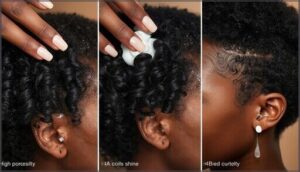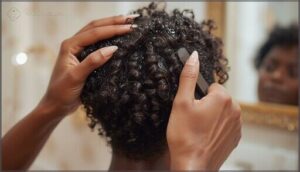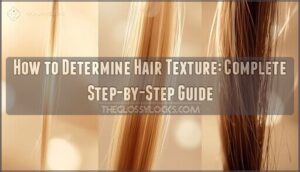This site is supported by our readers. We may earn a commission, at no cost to you, if you purchase through links.
You squeeze out way too much conditioner, your hair goes limp and greasy. Use too little, and you’re left with dry, brittle strands that won’t cooperate. Getting the right amount of conditioner for short African American hair isn’t just guesswork—it’s about understanding your hair’s unique needs and texture.
Short hair might seem like it needs less product across the board, but coily and kinky textures actually require precise conditioning to maintain moisture without weighing down your style. The difference between a dime-sized dollop and a quarter-sized portion can mean the gap between defined curls and a flat, oily mess.
Once you nail down the right measurement and application technique for your specific hair density and porosity, you’ll stop wasting product and start seeing the healthy, bouncy results you’ve been chasing.
Table Of Contents
Key Takeaways
- Start with a dime-sized amount of conditioner for most short African American hair textures, adjusting up to a quarter-sized portion only if you have thick, coarse, high-density hair that needs extra moisture.
- Your hair’s porosity matters more than length—high porosity hair (common in about 70% of African American women) loses moisture quickly and needs richer conditioners with butters and oils, while low porosity hair responds better to lighter formulas.
- Apply conditioner to damp hair that’s 70-80% wet, working from mid-shaft to ends rather than roots, and rinse for at least 60 seconds with cool water to prevent buildup and greasiness.
- Watch for over-conditioning signs like limp, greasy roots or unusual softness with fragility, and adjust your routine to condition 2-3 times per week with deep treatments weekly for optimal moisture balance.
How Much Conditioner for Short African American Hair?
Getting the right amount of conditioner for short African American hair doesn’t have to be a guessing game. You just need a starting point that works for your texture and density, then tweak from there.
Let’s break down exactly how much to use and how to adjust based on what your hair’s telling you.
Recommended Amount for Short Hair
Most folks use way too much conditioner on short hair. Here’s what actually works: a dime-sized amount covers short African American hair perfectly without weighing it down. For fine hair needs, even less does the trick. Focus on mid-lengths and damaged ends rather than your roots. To make certain your hair receives adequate moisture, consider that hair length matters when conditioning. Can’t spread it evenly? Try diluting conditioner with water first. Your hair products should add hair moisture, not greasiness.
Quick reference guide:
- Dime-sized portion – standard starting point for most short styles
- Pea-sized amount – ideal for very short or fine textured hair
- Apply mid-shaft down – keeps roots from getting oily and flat
- Quarter-sized max – only for thicker, coarser textures needing extra hydration
- Leave in conditioner separate – use sparingly as finishing step for hair dryness
Visual Guide to Measuring Conditioner
You’ve got the measurements—now let’s make them stick. Picture a dime on your palm: that’s your go-to coin-size portion for short African American hair. One pump from most bottles matches this perfectly.
Need precision? Dosage charts on packaging or spatula measures from beauty stores help nail the amount. Knowing which conditioner helps restore damaged hair is also important.
Tester samples at salons show exactly what works for your texture, keeping hair moisture balanced without the greasiness.
Adjusting for Hair Density and Thickness
Hair density needs shift based on how many strands pack your scalp. High density means using up to 50% more product—think nickel-size instead of dime. Thickness effects matter too: coarse strands demand richer formulas for better product absorption rates. Low density? Stick with less to dodge buildup.
Section your hair during application techniques for even coverage. Seasonal adjustments help—dry winters call for extra conditioning in African American hair care routines.
Factors Affecting Conditioner Usage
Not all short hair is the same, and neither is the amount of conditioner you’ll need. Your hair’s porosity, your scalp’s health, and even the type of conditioner you’re using all play a role in how much product works best.
Let’s break down the key factors that’ll help you find your perfect amount.
Hair Porosity and Texture
Think of your hair like a sponge—some absorb water instantly, others resist it. That’s porosity at work. About 70% of African American women have high porosity hair, meaning your strands lose moisture fast and need richer conditioners with butters and oils.
High porosity hair, common in 70% of African American women, loses moisture quickly and demands richer conditioning with butters and oils
Curly hair textures make product absorption tricky since sebum doesn’t coat hair follicles evenly, so you’ll need targeted lipid replenishment to keep those curls hydrated.
Scalp Condition and Health
Your scalp’s health directly shapes how much conditioner you’ll need. About 44% of African American women deal with itchy scalp or flaking at some point, so understanding what’s happening beneath those hair strands matters.
- Dandruff Prevalence: Microbiome balance gets disrupted when Staphylococcus aureus increases, making your scalp produce more flakes that trap product buildup.
- Styling Impact: Chemical relaxers and tight braids damage hair follicles, requiring gentler conditioning approaches.
- Nutrient Deficiencies: Low zinc and protein weaken hair structure and worsen scalp care needs.
- African American Skin: Natural dryness means you’ll absorb conditioner faster than someone with oily scalp conditions.
Product Type (Rinse-Out, Leave-In, Deep Conditioner)
The formula you choose changes everything. Rinse-out benefits include thorough cleansing but need a quarter-sized dollop for proper coverage. Leave-in hydration requires just a dime’s worth since it stays put. Deep conditioning demands more product—think golf-ball size spread across sections. Co-wash amounts mirror rinse-outs for cleansing power.
Watch for silicone buildup with heavy hair products, especially on African American skin’s natural dryness.
Step-by-Step Guide to Applying Conditioner
Applying conditioner the right way makes all the difference between soft, manageable hair and a greasy mess. The trick isn’t just about how much you use—it’s also about how you work it through your hair.
Let’s walk through the process step by step so you can get the most out of every application.
Prepping and Sectioning Short Hair
You’ll want to start your hair routine on damp, freshly cleansed strands—this is when African American skin and scalp are most receptive to moisture.
Use a wide-tooth comb for hair detangling, then divide your hair into four to six sections with clips. This parting precision sets you up perfectly for even leave-in conditioner application and proper moisture balance throughout.
Even Distribution Techniques
Here’s where your hair care routine really pays off: apply leave-in conditioner using the raking technique with your fingers, spreading the product through hair strands from back-to-front. Work in small sections for best results.
Remember, dampness levels matter—hair that’s 70-80% damp absorbs hair products better. This sectioning method helps you moisturize evenly without missing spots or creating buildup.
Using Tools: Fingers Vs. Wide-Tooth Comb
You’ve probably wondered whether your fingers or a wide-tooth comb works better when applying leave-in conditioner. Here’s what matters for Afro hair breakage prevention:
- Start with finger detangling to feel each knot and moisturize thoroughly
- Follow up with your wide-tooth comb for faster, even distribution
- Work on damp hair using proper detangling techniques from tips upward
- Combine both methods based on your hair texture and time available
Tips to Avoid Product Buildup and Greasiness
Using too much conditioner can weigh down your short hair and leave it looking greasy instead of healthy. The trick is knowing when you’ve crossed the line from well-moisturized to overloaded.
Let’s break down what to watch for and how to keep your hair light, clean, and perfectly conditioned.
Signs of Over-Conditioning
When your hair feels unusually limp or those greasy roots show up faster than usual, you’re looking at classic over-conditioning. You might notice a texture change—hair that’s too soft but oddly fragile. Watch for visual residue or scalp buildup that makes styling difficult.
These hair problems can lead to hair damage and hair breakage if ignored, so catching them early protects your hair care routine and keeps your hair treatment effective.
Rinsing Effectively
Once you’ve spotted those signs, proper rinsing becomes your best defense. Spend at least 60 seconds rinsing—double your lathering time—to clear out hair products and prevent buildup. Cool water between 59°F and 70°F works wonders, closing cuticles and locking in moisture, while warm water above 86°F increases frizz.
Use a wide-tooth comb as your rinsing tool for better water coverage, and add a clarifying shampoo every three washes to keep your hair routine balanced.
Frequency of Conditioning for Short Hair
Getting your hair routine right means finding the sweet spot with conditioning frequency. Most short African American hair types thrive on 2-3 times per week, though your lifestyle plays a big role.
Here’s what works:
- Use leave in conditioner daily for moisture between washes
- Deep condition weekly to lock in hydration
- Watch for over-conditioning signs like greasiness or limp strands
- Make seasonal adjustments when cold weather hits
Active lifestyles need more frequent moisturising, while your hair regimens should adapt to what your hair tells you.
Best Conditioners for Short African American Hair
Finding the right conditioner can feel like searching for a needle in a haystack when you’re standing in the hair care aisle. The truth is, not all conditioners are created equal, especially concerning short African American hair with its unique needs.
Let’s break down what ingredients to look for, how to match products to your specific hair type, and when to reach for a deep conditioner versus a leave-in.
Moisturizing and Nourishing Ingredients to Look For
When you’re scanning labels, look for natural oils like coconut oil and shea butter—they lock in moisture using the LOC method. Protein components repair damage, while emollient agents smooth your strands. Scalp enhancers keep your roots healthy.
Skip products loaded with harmful additives like sulfates and parabens. Whether you’re using a leave-in conditioner or deep treatment, these ingredients make all the difference.
Choosing Products for Your Hair Type
Once you know what ingredients work, you need to match products to your hair’s personality. Your hair’s porosity needs drive everything—high porosity hair drinks up heavy moisturizers, while low porosity responds better to lighter formulas. Test products on a small section first to see how your hair reacts.
Key considerations for your hair routine:
- Texture compatibility matters more than brand names when building your Afro hair care products collection
- Budget considerations shouldn’t mean sacrificing quality—drugstore leave-in conditioner options often work just as well
- Ingredient analysis helps you spot what your Afro hair actually needs versus marketing hype
When to Use Deep Vs. Leave-in Conditioners
When your Afro hair feels brittle or damaged, reach for a deep conditioner every 1–2 weeks to restore strength and moisturise deeply.
Leave-in conditioner works better for daily hair care—apply it after every wash to support your hair routine with lightweight hydration.
Match your application frequency to your hair type and hydration needs, adjusting based on desired results and current hair damage level.
Frequently Asked Questions (FAQs)
Can I mix different conditioners together safely?
You can mix conditioners in your hand for immediate use, but avoid pre-mixing in bottles.
Different formulas may clash, causing pH alteration and ingredient reactions that compromise formulation stability and hair health.
Does water temperature affect conditioner absorption rates?
Yes—warm water (95–105°F) boosts cuticle permeability and scalp blood flow for better absorption.
Cold rinses seal hydration retention but limit leave-in conditioner penetration, potentially causing product residue and hair problems that weaving or combating Afro hair health requires avoiding.
Should I condition before or after shampooing?
Condition after you shampoo to restore moisture and seal those cuticles—that’s the ideal approach for your hair type.
Reverse washing can help if you struggle with frizz, but post-cleanse conditioning wins for hydration.
How long should conditioner sit on hair?
Ironically, people obsess over product amounts but ignore timing—yet that’s what really matters for hair care.
Leave rinse-out conditioner for 2-5 minutes, deep conditioner 10-30 minutes with heat for better moisturisation and porosity effects.
Can conditioner expire or lose its effectiveness?
Absolutely. Most conditioners last 12 to 24 months, but they can lose effectiveness and even harbor bacteria after expiring. Watch for odd smells, texture changes, or separation—those are clear signs it’s time to toss it.
Conclusion
Mastering how much conditioner to use for short African American hair might feel like cracking a secret code, but once you do, everything clicks into place. Start with a quarter-sized amount, adjust for your density and porosity, and watch how your curls respond.
You’ll stop second-guessing every wash day and start enjoying hair that feels soft, defined, and healthy. That confidence? It shows up in everything you do.
- https://www.adorebeauty.com.au/beautyiq/hair/conditioner/how-much-conditioner/
- https://www.tiktok.com/@allthings_manteme/video/7480162690543963398
- https://www.reddit.com/r/HaircareScience/comments/tpyc9u/how_exactly_do_you_use_conditioner_on_short_hair/
- https://pubmed.ncbi.nlm.nih.gov/31641276/
- https://hairingcaring.com/best-type-of-conditioners-for-natural-hair/










